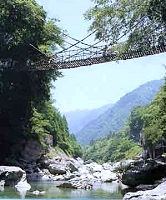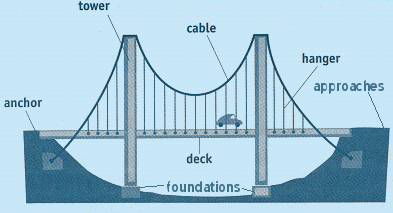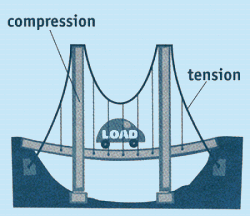
The History | How They Work | Anatomy | Amazing Bridges
Up close, the suspension bridge is an amazing and beautiful structure that can span rivers and connect cities hundreds of miles apart. From a distance they look fragile, hanging from almost transparent threads. Despite their seeming fragility, suspension bridges are very, very strong thanks to their design and the materials used to build them. These awe-inspiring bridges alone balance the forces of tension and compression, managing to stay up through hurricanes, storms, and earth-quakes.
The History
 The first suspension bridges were not the imposing steel and stone structures you think. In fact, the first suspension bridges are the handing vine bridges found in South America, Africa, and Asia. Thousands of years ago, people hung cables, fashioned from twisted vines, from trees on one side of a river or canyon to join trees on the other side. The cable-vines held up strong twigs and planks of wood to create a platform. These early suspension bridges were important for enabling people to travel faster across rivers and canyons. The first suspension bridges were not the imposing steel and stone structures you think. In fact, the first suspension bridges are the handing vine bridges found in South America, Africa, and Asia. Thousands of years ago, people hung cables, fashioned from twisted vines, from trees on one side of a river or canyon to join trees on the other side. The cable-vines held up strong twigs and planks of wood to create a platform. These early suspension bridges were important for enabling people to travel faster across rivers and canyons.
 Now, rivers can also be crossed using suspension bridges - albeit, bridges that are a lot more sophisticated, stronger, and longer. John Roebling dreamed up the first modern suspension bridge in 1867. He believed that a long suspension bridge, today called the Brooklyn Bridge, could connect Manhatten and Brooklyn, New York. Other engineers believed that the feat couldn't be done. But Roebling spent two years planning and checking every detail and calculation twice.
Now, rivers can also be crossed using suspension bridges - albeit, bridges that are a lot more sophisticated, stronger, and longer. John Roebling dreamed up the first modern suspension bridge in 1867. He believed that a long suspension bridge, today called the Brooklyn Bridge, could connect Manhatten and Brooklyn, New York. Other engineers believed that the feat couldn't be done. But Roebling spent two years planning and checking every detail and calculation twice.
It took 14 more years to build the bridge, but John Roebling didn't live to see it finished. Just two weeks after the project began, Roebling injured his right foot in an accident at the bridge site. Doctors amputated his toes, but his foot became infected, and he died.
 His son Washington, also an engineer and bridge builder, took over his father's dream. But during the first three years on the project, he became sick and was bedridden. Although, not an engineer, Emily Warren Roebling, his wife, took over the project. She soon became knowledgable in the language of bridges and an expert in bridge construction. She would meet with the engineers at the bridge site, and then return to her husband's bedside, bringing him news and questions. Emily oversaw the completion of the bridge, and Washington, who orchestrated the construction, never left his bed the whole time the Brroklyn Brdige was built.
His son Washington, also an engineer and bridge builder, took over his father's dream. But during the first three years on the project, he became sick and was bedridden. Although, not an engineer, Emily Warren Roebling, his wife, took over the project. She soon became knowledgable in the language of bridges and an expert in bridge construction. She would meet with the engineers at the bridge site, and then return to her husband's bedside, bringing him news and questions. Emily oversaw the completion of the bridge, and Washington, who orchestrated the construction, never left his bed the whole time the Brroklyn Brdige was built.

Anatomy of a Bridge
Deck - For pedestrian, train, and/or automobile traffic.
Supports - The towers are the supports.
Span - Describes the distance between towers.
Foundations - The supports rest on the foundations.
Approaches - The approaches are the roads leading up to the bridge.
Long wire cables are strung over the towers and secured to the anchors on land.
Hangers run from the cables to the deck hold it up.



How They Work
Any bridge can only stay up if it can support its own weight (called the dead load) and the weight of all the traffic that crosses it (called the live load). The load creates 2 major forces that act on parts of a bridge. The 2 forces are Compression and Tension:

Compression - The force of compression pushes down on the suspension bridge's deck. but because its a suspended roadway, the cables transfer the compression to the towers, which dissipate the compression directly into the earth where they're firmly entrenched.
Tension - The supporting cables, running between 2 anchorages, are the lucky recipients of the tension forces. The cables are literally stretched from the weight of the bridge and its traffic as they run from anchorage to anchorage. The anchorages are also under tension, but since they, like the towers, are held firmly to the earth, the tension they experience is dissipated.
Suspension bridges are capable of spanning long distances and actually are the only type of bridge to span the longest distances possible for a bridge. This is because the shape of the suspension bridge is actually one of the most stable structures there is. The cable of the bridge is inherently stable against any disturbance if it is thick enough to withstand any tension. The forces (tension mostly) are carried to the tops of the high towers (which should and usually are resilient against flexure, buckling, and oscillation) through the cables, instead of being directed towards the ground - which would happen if the bridge is an arch bridge. But what sets the suspension bridge apart from most conventional bridges is that all the forces do not "internally-cancel." Instead, the forces are directed in a way that the tensions are resisted by the ground, which is in compression!


Amazing Bridges!
Click on a bridge to learn more about each one!

go to

or go to previous page
|



